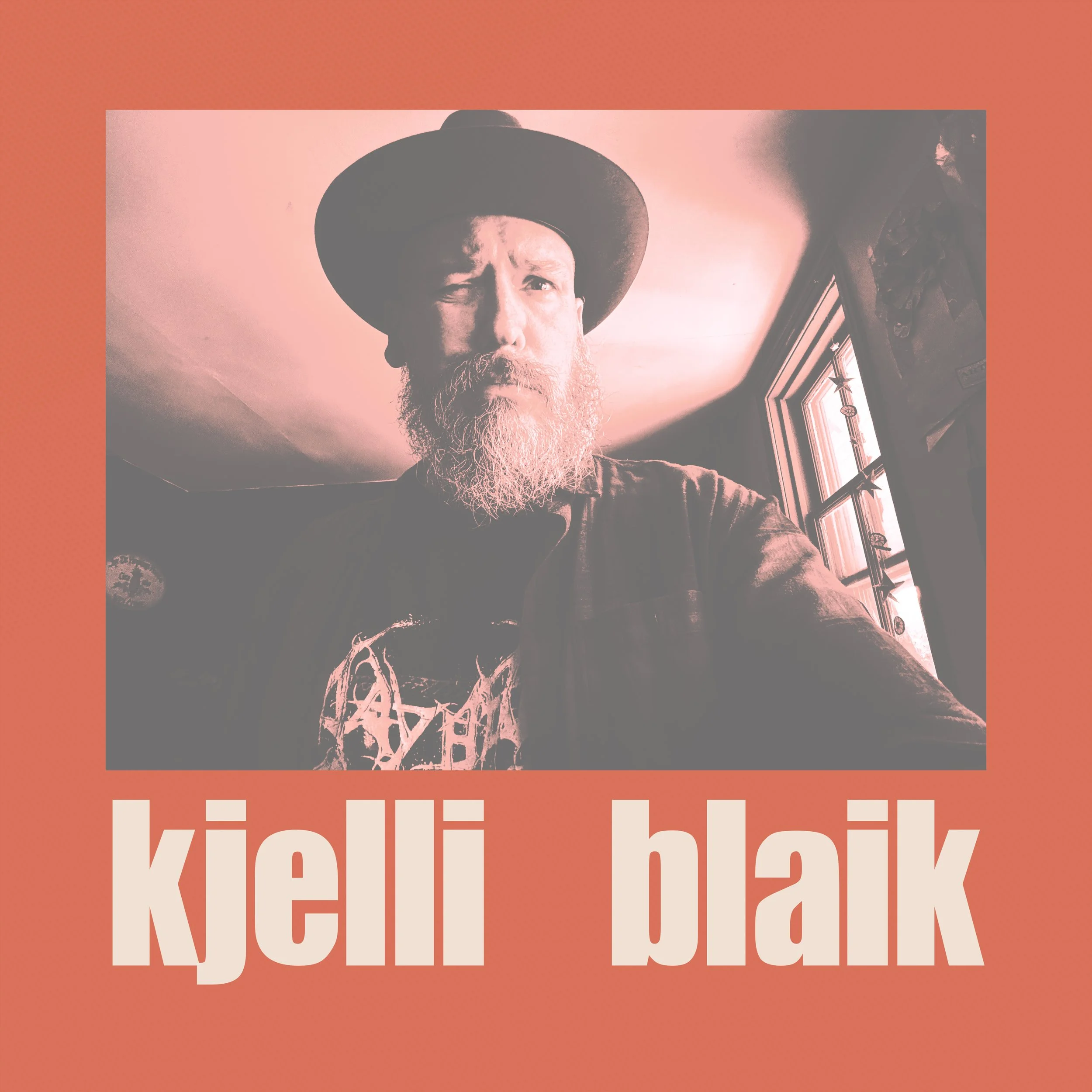What’s that noise?
The Departure
Raised on WAMU’s bluegrass broadcasts out of Washington, D.C., our protagonist began with acoustic folk, blues, and bluegrass before detouring into punk basements and hardcore shows. By the mid-’90s, he had returned to the acoustic guitar and, armed with a 4-track cassette recorder, produced a run of lo-fi folk albums that critics praised as raw, fractured, and painfully intimate. During the summer of 1996, he disappeared for the first time — only reemerging four years later as a transplant to New England.
The stripped-down acoustic record Folk Blues & Things to Use, recorded with artist Will Schaff, was released in the year 2000 and hailed by Demo Universe as “a 21st-century version of The Freewheelin’ Bob Dylan… luminous lyricism and sad, stark beauty.”
But the more people seemed to like his music and wanted to see him out on the road or slot him into scenes like New York’s Anti-Folk, the more he pulled away. In a contemporaneous interview, CIty Paper noted that: he “has earned some very favorable reviews and has gotten hooked up with like minds at record labels, clubs, and in home-taping bedrooms all over, but… seems uninterested in exploiting this minor buzz."
The Wanderings
What followed was a decades-long odyssey across the deep oceans and through the far reaches of underground music. Always changing direction as soon as things would start to become too clear, he would find himself playing in rooms where he never belonged and with players far more dedicated to their craft.
He was dedicated only to wandering.
Over the next few years, the output became increasingly eclectic — and this fueled a growing complexity, paranoia, and even absurdity. The discombobulating effect of homemade albums released at this time is summed up well by a contemporary review:
“It's when you're at the Scrabble tournament and you've just spelled the word ‘singersongwriter’ and there's a squawking sound, a brief electric buzz. You look up and there's a stork in the corner, long-legged, bearing an electric guitar. He stops playing, he looks at you, he blinks his eyes. ‘Yeah, what?’ he seems to be saying, in stork. And when you look back down the word ‘singersongwriter’ has been changed, either by cheating or by some obscure rule. And your tiles now say: ‘Elope, elope, elope, elope!’” — Said the Gramophone (2006)
Returning to Baltimore, our songwriter met and began collaborating with bassist Joel Grip who was studying at the Peabody Conservatory at the time. Their partnership led to occasional independent touring and eventually to the project The Violencestring (2007). A “Free Jazz Tommy”, as one reviewer put it, the album brought together players from European free improvisation, American free jazz and non-idiomatic art music, and folk traditions.
Players included the pianist Eve Risser; Swedish trumpeter Niklas Barnö; Baltimore stalwarts John Dierker, Lawrence Lanahan, and Lyle Kissack; sound experimenter Jenny Graf Sheppard; Nautical Almanac’s Twig Harper and Carly Ptak; and many more. Produced by Matthew H. Welch, it was released on Umlaut Records in Europe and on Fall Records in the States.
Q. “Right, and where you had been getting into weirder stuff in a sort of noise-meets-folk thing, this release with all these great players just completely went off the rails.”
A. “I guess so. Joel had introduced me to European free improvised music. And I sort of introduced him to Appalachian music and hobo music, Dust Bowl music, and other kinds of folk and blues-based music from the States. When we played together, we tried to create a blend of these things. Like: Woody Guthrie, but if accompanied by Derek Bailey instead of Cisco Houston.”
In Baltimore, he became associated with the experimental High Zero Festival, both as performer and co-organizer. In reviewing one edition of the annual concert series, NPR Music scolded him for “shoving as many things as he could into the strings of his guitar” (including a toy xylophone) while The Wire praised his “thorough exploration of possible sound.” In an effort to break through what was becoming an increasingly insular musical viewpoint, he joined a honky-tonk band and released several live sessions, including a lo-fi C&W set recorded at Shakemore — the annual fringe fest organized by Half Japanese.
Frustrated by his own name, he began creating albums under a carousel of pseudonyms — treating songs as though sung by characters in musicals or films. “I’ve always felt more like a film director than a musician. Like, when I’ve written albums, I’ve thought about the songs in terms of light and darkness and blocking and what point-of-view the listener gets to observe. Sometimes in the past I’d sing things from the point-of-view of a character, and listeners would confuse that with who I am personally. By using aliases, it let me explore music more fully. I could create characters who would sing my songs. And I could explore genres unapologetically. There was no pressure other than the act of creation itself.”
From punk houses to free-jazz festivals, his music kept mutating — and he kept disappearing and reappearing. Until by the late 2000s, most assumed he’d left it behind.
The Return
But the sailor was still at sea, gathering stories.
In 2018, our hero quietly released three singles with his wife MJ — one picked up by Mike Watt’s radio show. “That sort of got my attention that people might still be interested.”
Just prior to the pandemic, he converted much of his kitchen into a makeshift recording studio. And over the next five years, he would produce music at a blistering rate — releasing over twenty anonymous projects across a range of complicated genres from black metal to ambient techno.
Then, in December 2024, things changed.
Q. “So why the decision to come out now with new music, more or less ‘in your own name’?”
A. “So, last December I suffered a stroke in my eye. That put me on notice, as it were. In the time leading up to that, I’d been playing in a weekly bluegrass jam down in Hyattsville, Maryland. The jam was organized by Barb Diederich and her husband Tom Gray. And I learned a lot working with that group. Tom was the bass player on the early 60’s recordings of The Country Gentlemen and later played in The Seldom Scene – both sort of big projects in the development of a more progressive sort of bluegrass. When I was a kid, bluegrass had been like a cultural soundtrack as it blasted through on the radio out of DC. And when I started playing guitar, it was acoustic folk and blues and bluegrass that I learned to play before ever getting into punk or metal or whatever. So, spending over a year hanging with this group in Hyattsville was a great way to disappear into music.”
Q. “And then the eye thing happens?”
A. “Yeah, so I can’t drive because I lose most of my vision. So, I can’t get to the jam. So, I’m at home with these bluegrass and Old Time songs going through my head and I just start writing new lyrics to them. That’s how this whole new thing starts. And before I know it, I’ve got an album of material that, ironically, probably sounds like the logical next-step of what I should have done 25 years ago had I not taken a crazy detour into some weird music.”
A Homecoming
And so today, the songwriter who was once compared to a hip stork emerges under the name Kjelli Blaik — the first name a moniker given by Swedish trumpeter Niklas Barnö on tour (but the whole name phonetically symmetrical to the name he’d used on his records all those decades back). The name is concurrently a mask and maybe something of a revelation, a way to honor the wandering while acknowledging the return.
And the music this time around? Well, it is mostly acoustic, but more raw and rough-hewn (without the distractions of novel sound effects and free improv — and a bit less navel-gazing than the work of his 20-something year old self back in the 90’s).
But despite the stripped-down nature of the project, it somehow comes across as even more fractured than before. Upright bass pounds away keeping the rhythm propulsive, an old-time clawhammer banjo weaves in and out of the mix, the mandolin plays naïve melodies, and the guitars are usually arpeggiated and play somewhat behind the beat. The music is occasionally accented by a bodhrán or by a percussive clav. And an organ tattered by tremolo warbles in a drunken harmony. The voice — present as ever — is rough, cracked, and more lived-in. It is still sloppy and achey. And it carries the weight of the intervening decades.
An Odyssey
Kjelli Blaik creates a sound that is pure East Coast grit. It contains the memories of Baltimore basements and warehouse parties, New England four-tracks tracking incoming storms, and bluegrass radio stations eternally transmitting lonesome heartache. His relationship to music has not been a straight line — but rather an odyssey: including a departure, long wanderings, trials, and now, a return home. This odyssey takes place in a setting where myth and reality blend into a new kind of “real”.
And as Demo Universe once asked, when reviewing his output at the turn of the century: “Isn’t it time you heard something real?”
What does Kjelli do?
Presently, he makes cracked, rough-edged folk songs where the bass thunders and the voice lays bare each scar picked up on a decades-long trip through strangeness and outsider Americana. That’s a funny way to say he writes music.
He also writes stories — which aspire to read better than his marketing copy.
Interested in the music? Click below to check out Kjelli’s more-or-less complete discography — including links to songs and albums.


